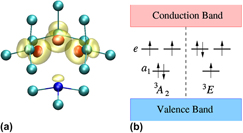Crossref Citations
This article has been cited by the following publications. This list is generated based on data provided by
Crossref.
Tien Son, Nguyen
Thang Trinh, Xuan
Gällström, Andreas
Leone, Stefano
Kordina, Olof
Janzén, Erik
Szász, Krisztián
Ivády, Viktor
and
Gali, Adam
2012.
Electron paramagnetic resonance and theoretical studies of Nb in 4H- and 6H-SiC.
Journal of Applied Physics,
Vol. 112,
Issue. 8,
Somogyi, Bálint
Zólyomi, Viktor
and
Gali, Adam
2012.
Near-infrared luminescent cubic silicon carbide nanocrystals for in vivo biomarker applications: an ab initio study.
Nanoscale,
Vol. 4,
Issue. 24,
p.
7720.
Szász, Krisztián
Hornos, Tamás
Marsman, Martijn
and
Gali, Adam
2013.
Hyperfine coupling of point defects in semiconductors by hybrid density functional calculations: The role of core spin polarization.
Physical Review B,
Vol. 88,
Issue. 7,
Solenov, Dmitry
Economou, Sophia E.
and
Reinecke, Thomas L.
2013.
Two-qubit quantum gates for defect qubits in diamond and similar systems.
Physical Review B,
Vol. 88,
Issue. 16,
Wang, Xiaopeng
Zhao, Mingwen
Bu, Hongxia
Zhang, Hongyu
He, Xiujie
and
Wang, Aizhu
2013.
Formation and annealing behaviors of qubit centers in 4H-SiC from first principles.
Journal of Applied Physics,
Vol. 114,
Issue. 19,
Sabli, Nordin
Talib, Zainal Abidin
Yunus, Wan Mahmood Mat
Zainal, Zulkarnain
Hilal, Hikmat S.
and
Fujii, Masatoshi
2014.
Film electrodes deposited from Cu2SnSe3 source in comparison with those deposited from SnSe and Cu2ZnSnSe4 sources by thermal vacuum evaporation: Effect of argon gas flow rate.
Electrochimica Acta,
Vol. 139,
Issue. ,
p.
238.
Freysoldt, Christoph
Grabowski, Blazej
Hickel, Tilmann
Neugebauer, Jörg
Kresse, Georg
Janotti, Anderson
and
Van de Walle, Chris G.
2014.
First-principles calculations for point defects in solids.
Reviews of Modern Physics,
Vol. 86,
Issue. 1,
p.
253.
Solenov, Dmitry
Economou, Sophia E.
and
Reinecke, Thomas L.
2014.
Excitation spectrum as a resource for efficient two-qubit entangling gates.
Physical Review B,
Vol. 89,
Issue. 15,
Demján, Tamás
Vörös, Márton
Palummo, Maurizia
and
Gali, Adam
2014.
Electronic and optical properties of pure and modified diamondoids studied by many-body perturbation theory and time-dependent density functional theory.
The Journal of Chemical Physics,
Vol. 141,
Issue. 6,
Castelletto, S.
Johnson, B. C.
Ivády, V.
Stavrias, N.
Umeda, T.
Gali, A.
and
Ohshima, T.
2014.
A silicon carbide room-temperature single-photon source.
Nature Materials,
Vol. 13,
Issue. 2,
p.
151.
Hain, T. C.
Fuchs, F.
Soltamov, V. A.
Baranov, P. G.
Astakhov, G. V.
Hertel, T.
and
Dyakonov, V.
2014.
Excitation and recombination dynamics of vacancy-related spin centers in silicon carbide.
Journal of Applied Physics,
Vol. 115,
Issue. 13,
Somogyi, Bálint
and
Gali, Adam
2014.
Computational design ofin vivobiomarkers.
Journal of Physics: Condensed Matter,
Vol. 26,
Issue. 14,
p.
143202.
Bodrog, Zoltán
Gali, Adam
Varró, S.
Ádám, P.
Biró, T.S.
Barnaföldi, G.G.
and
Lévai, P.
2014.
Two-site diamond-like point defects as new single-photon emitters.
EPJ Web of Conferences,
Vol. 78,
Issue. ,
p.
05001.
Fuchs, F.
Stender, B.
Trupke, M.
Simin, D.
Pflaum, J.
Dyakonov, V.
and
Astakhov, G. V.
2015.
Engineering near-infrared single-photon emitters with optically active spins in ultrapure silicon carbide.
Nature Communications,
Vol. 6,
Issue. 1,
Gordon, L.
Janotti, A.
and
Van de Walle, C. G.
2015.
Defects as qubits in3C−and4H−SiC.
Physical Review B,
Vol. 92,
Issue. 4,
Szász, Krisztián
Ivády, Viktor
Abrikosov, Igor A.
Janzén, Erik
Bockstedte, Michel
and
Gali, Adam
2015.
Spin and photophysics of carbon-antisite vacancy defect in4Hsilicon carbide: A potential quantum bit.
Physical Review B,
Vol. 91,
Issue. 12,
Ivády, Viktor
Szász, Krisztián
Falk, Abram L.
Klimov, Paul V.
Christle, David J.
Janzén, Erik
Abrikosov, Igor A.
Awschalom, David D.
and
Gali, Adam
2015.
Theoretical model of dynamic spin polarization of nuclei coupled to paramagnetic point defects in diamond and silicon carbide.
Physical Review B,
Vol. 92,
Issue. 11,
Ananina, O. Yu.
and
Severina, E. V.
2016.
Simulation of a vacancy defect at the C(111)–2 × 1 surface.
Journal of Surface Investigation. X-ray, Synchrotron and Neutron Techniques,
Vol. 10,
Issue. 3,
p.
542.
Cottom, J.
Gruber, G.
Hadley, P.
Koch, M.
Pobegen, G.
Aichinger, T.
and
Shluger, A.
2016.
Recombination centers in 4H-SiC investigated by electrically detected magnetic resonance and ab initio modeling.
Journal of Applied Physics,
Vol. 119,
Issue. 18,
Soykal, Ö. O.
Dev, Pratibha
and
Economou, Sophia E.
2016.
Silicon vacancy center in4H-SiC: Electronic structure and spin-photon interfaces.
Physical Review B,
Vol. 93,
Issue. 8,



